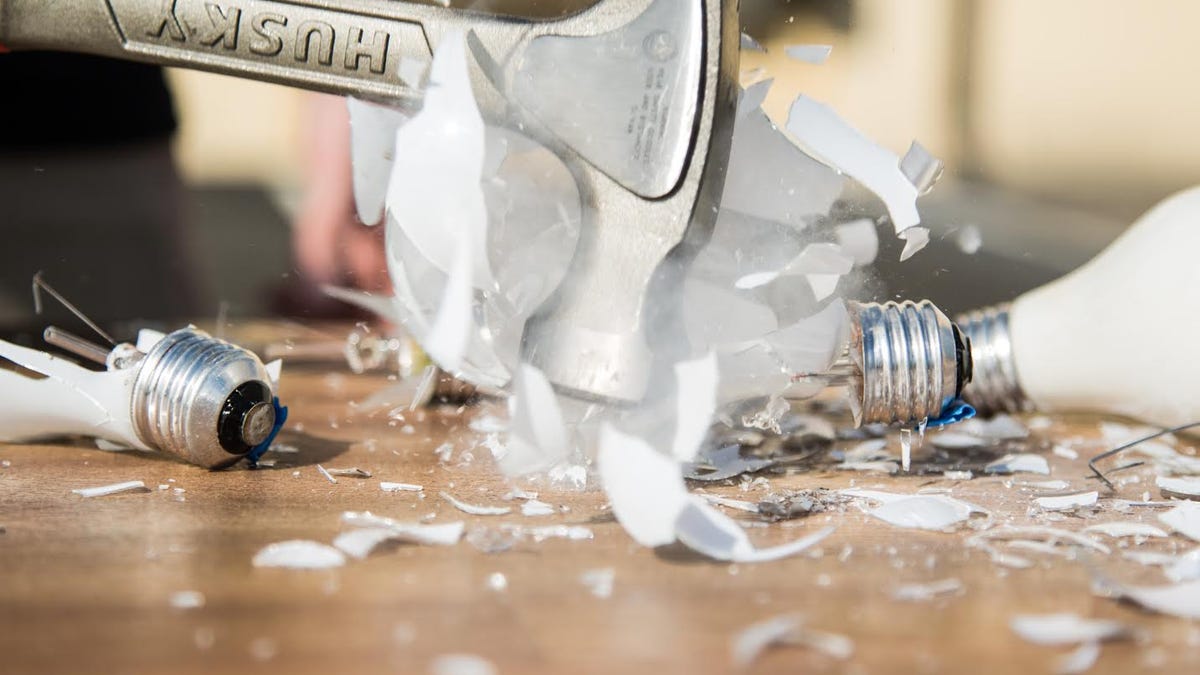Let's smash some light bulbs
Want to see the inner workings of your everyday light bulb? Grab your safety goggles and let's take a look.

Ever wonder how different kinds of light bulbs work? Good, you've come to the right place.
Just want to see some glorious slow-mo shots of light bulbs getting annihilated with a hammer? You, my friend, are in luck as well.
See, the science of how different kinds of light bulbs manage to emit light is pretty interesting. But, as with the old saying about omelets, you can't take a closer look without breaking a few bulbs. Fortunately, the CNET Smart Home and Appliances team has plenty of hammers on hand in our test lab in Louisville, Kentucky, along with the requisite safety gear and even a slick slow-motion camera on loan to us from CNET San Francisco (thanks, guys!)
So yeah. We're going to smash a bunch of light bulbs today.
Up first, the incandescent
The incandescent is the iconic design that most people think of when they think of a light bulb. Thomas Edison invented it well over a hundred years ago, and it's been lighting up our world ever since.
Incandescents work by stringing up a tungsten-coated filament between two conductive spires. When you flip the switch, electricity passes through that filament -- the electricity heats the filament up and causes it to glow.
Incandescents work because tungsten, a chemical element with a very high melting point, is incredibly rugged and dense. It can handle the heat, so to speak.
But therein lies the problem. With incandescents, most of your electricity is getting converted to heat energy, with only a fraction coming out as light energy. That isn't a terribly efficient way to make electricity into light.
Hello, halogens
This is where halogens come in. They're really just incandescents with a little chamber of halogen gas surrounding the filament. That gas, usually bromine or iodine, reacts with the tungsten as it evaporates and recycles some of that tungsten back onto the filament. That extends the life of the bulb, and also helps it put out more light using less energy.
Most halogen bulbs are virtually indistinguishable from incandescents, and they don't cost that much more than incandescents, either. That makes a them a fine option if you're in need of a light bulb but not ready to spend the extra cash for something more modern.
See ya, CFL
For an even more efficient alternative to incandescents, you could go with a compact fluorescent light (CFL). Each one is a tube that's twisted into something resembling a light bulb. When you turn it on, electricity excites the fluorescent gasses inside, which produces light.
Notice that the glass isn't see-through? That's because it's coated with a special mix of rare-earth metals that helps the bulb put out the right kind of light, and the right amount of it, too. That loose, white powder is more of the same stuff -- it stays suspended in the bulb to help aid in the fluorescent process.
But what about those fluorescent gasses? They include neon, argon and yep, trace amounts of mercury. Mercury is potentially dangerous if ingested, so if you break a CFL like we did, you'll want to clean it up pretty carefully. First, clear the area, open some windows and let things air out for 15 minutes or so. Then, sweep everything up into a sealable container and, if you can, drop it off at your local recycling or waste management center. And don't use a vacuum cleaner, as it might kick some of those harmful chemicals up into the air.
Last, LEDs
If the thought of a broken CFL sounds like too much of a headache, then consider an LED. It's an even more efficient option than that fluorescent, and there's no mercury to worry about.
LED stands for "light-emitting diode," and each LED bulb is filled with the things. They're those little yellow squares in this busted Philips bulb, and each one is basically a tiny electrical junction between two nodes. When electricity passes through, electrons jump from one node to the other, and as they do, they emit light. It's a process called "electroluminescence," and it's much, much more efficient than other ways of lighting up a bulb.
How efficient? Well, say your energy rate is $0.12 per kWh. Using a standard 60W incandescent light bulb for an average of 3 hours a day will add about $7 to your yearly power bill. A 60W replacement LED like the one we just clobbered will add about a buck over the same period.
LEDs typically cost a lot more upfront than incandescents, halogens and CFLs, but a lot of surprisingly affordable options have emerged, including 60W replacements that sell for $5 or less. Bulbs like those pay for themselves within the first year of use if you're upgrading from an incandescent -- and unlike that incandescent, which will only last you about a year, they're made to keep on putting out light for decades.
Then again, when your light bulbs are made to last for 10 or even 20 years, it gets increasingly important to buy the right ones for your home. That's precisely why CNET tests and reviews light bulbs of all shapes and sizes.
And occasionally, why we smash them, too.

